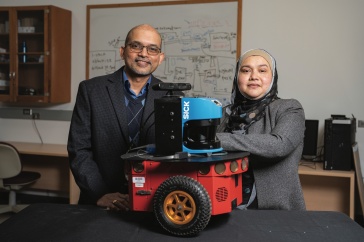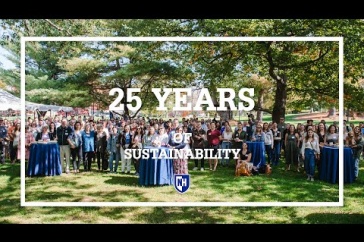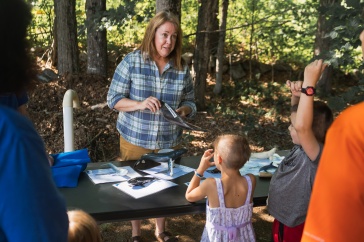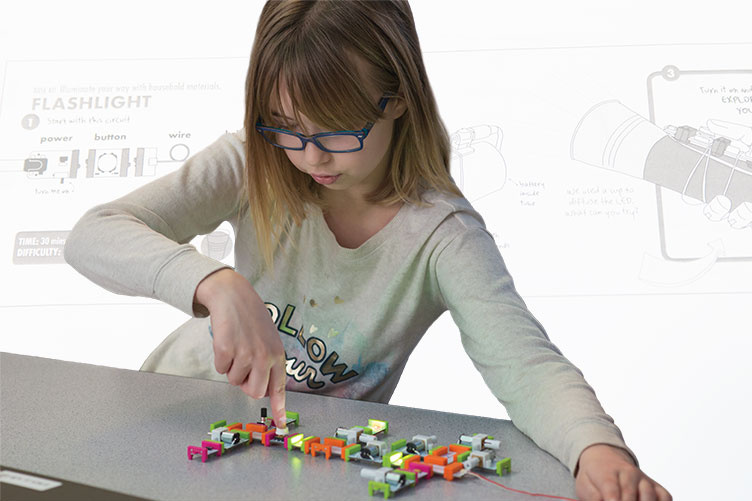
Inspiration’s in the air early on a Thursday morning at the East Rochester School. The fifth graders in Jenna Buinicky’s weekly technology class are already excited—there’s just one more day until February vacation—but when Buinicky ’99, ’01G reveals the day’s lesson, their enthusiasm ratchets up.
“Today, you guys will be working with LittleBits,” Buinicky says. Some of the kids already know about LittleBits—they’re like Legos, but with circuits, motors, switches and lights that snap together instead of plastic bricks.
For the kids who don’t know, Buinicky puts a YouTube video on the screen at the front of the classroom. Brightly colored pieces are connected, a button is pressed, and suddenly, motors spin, lights blink and simple inventions come to life. So does the classroom.
“In the video, there’s a battery, a switch and a dimmer. What tool in your house is made up of these things?” Buinicky asks.
“Oh! A flashlight!” someone shouts.
Other LittleBits pieces flash on screen—LED lights, a beeping alarm, a vibrating buzzer. “I know another thing you can make!” another student says. “A video game controller!”
“Or a hand buzzer!” a third student exclaims.
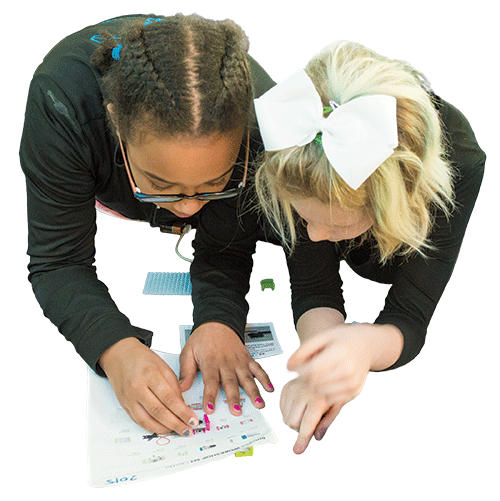
“That’s right,” Buinicky says. “And actually, that’s one of your challenges today.” In teams of three or four, she explains, the students will get a series of schematics showing them the LittleBits pieces they’ll need. They’ll have to figure out how the pieces work together, she says; the inventions start simple and grow more complicated—from a flashlight to a “tickle machine” to a wrist-mounted hand buzzer.
Buinicky hands out the first set of challenges and the kids spring into action, forming groups and racing to the plastic cases where the LittleBits are stored. In one corner of the room, two girls hurry through the challenges so that they have time to build their own inventions.
“We’re just making many different creations,” one girl says, snapping together a cluster of LittleBits. The other presses two buttons, and an array of motors start spinning at different speeds. “We’re trying to figure out how the pulses work,” she tells Buinicky.
On the other side of the room, a trio of boys has used elastics, a paper tube and LittleBits to make a flashlight. They’ve attached an alarm to the flashlight set up, though, and every time they turn on the light, an obnoxious buzzing sound joins it.
“Look, it’s an interrogation device!” one boy says, flashing the light in a friend’s face. He’s incredibly proud. “My group helped me make it. They’re awesome.”
Like the buzzing flashlight, the morning’s class was a group effort. For the last two years, Rochester’s school district has partnered with UNH through the Joan and James Leitzel Center for Mathematics, Science and Engineering Education’s STEM Teachers’ Collaborative program to augment the district’s STEM curriculum. That collaboration includes an equipment-lending program for teachers like Buinicky.
“We wouldn’t be able to afford LittleBits without UNH,” she says.
Scenes like this play out every day across New Hampshire. The bonds between UNH and Granite State schools and communities have deep roots, and in the 150 years since the university was founded, those partnerships have only grown stronger. They take place in high school classrooms and university lecture halls, in research labs and town halls. The collaborations are as varied as the communities themselves, and each connection yields surprising results for everyone involved.
And those results accumulate into something big. As Julie Williams, senior vice provost for engagement and academic outreach, puts it, “The partnerships are about being good collaborators on the grand challenges of our day. And with the help of the communities we partner with, we can do a better job at answering some of those big questions.”

Tying shoes and shaking it off
Sometimes, answering those big questions starts with something small—like tying shoes.
That’s the case in Sharon Shea and Abigail Thompson’s first-grade classroom at Woodman Park School in Dover. Shea is a veteran teacher with 30 years of experience; Thompson ’16, ’17G is a graduate student and intern who’s been co-teaching with Shea since the beginning of the 2016 school year.
“It’s like sharing an apartment together,” Shea jokes. But the level of collaboration between interns like Thompson and cooperating teachers like Shea is that deep. The two plan lessons together, hold parent conferences together and, as far as the students are concerned, Thompson is just as much a “real” teacher as Shea.
“The things I’ve gotten to experience are invaluable,” Thompson says. “Team-teaching is a huge part of our classroom. I’m able to start a lesson and then Sharon’s able to jump in. It’s just the little things, like helping someone tie their shoes. If I’m teaching a lesson and they need help from someone, it’s easy for me to say, ‘Why don’t you go see Mrs. Shea?’”
For experienced teachers like Shea, the education department’s internship program infuses a “spark of enthusiasm and energy” each year. She’s worked with so many interns she’s lost count, she says, but the outcome for her and her students is consistent.
“The more time I have to sit down and collaborate with interns like Abby, the more it’s helped me grow as an educator, which is something that’s fantastic for our profession,” Shea says.
For Thompson, the partnership provides invaluable insights into classroom dynamics and the complexities of student learning. Minor missteps and lesson plans that fall flat are just as valuable for Thompson as the days when lessons go off without a snag.
One lesson in particular drove this point home for Thompson. Shea was out one day, and Thompson was by herself in the classroom. The day’s agenda included a math lesson—one Thompson was confident couldn’t fail.
“The lesson went great,” she says. “But then I sent the kids back to their seats, and the reality of the content hit me. All these kids were coming up to me and asking questions. First one kid, then another, then another. And so then I said, ‘OK, everyone put everything down. We need to reconfigure this.’”
That night at home, Thompson thought about where she went wrong. She was flustered. She called Shea and said, “I really messed up.”
“No you didn’t,” Shea told her. “We just need to go back and figure out what went wrong so we can make it better for the students.”
And so Thompson took another look. She reached out to other Woodman Park first-grade teachers and overhauled everything, down to the seating arrangements. “It wasn’t just the content, or how the kids were accessing the content, it was the seating, it was where I was demonstrating things. There are so many factors that play into a lesson,” Thompson says.
Thompson tried again the next day. But before the math lesson began, she told the students to stand up. “I said, ‘Everyone just shake,’ and they all said, ‘Why?’ And I told them we’re shaking off yesterday’s lesson and we’re starting again. And it went great.”
The education department’s relationship with communities isn’t limited to classrooms. Woodman Park and other local schools participate in the department’s Seacoast Reads program, which places UNH undergraduate student volunteers in local schools and libraries to help elementary and middle school students work on literacy skills. At Woodman Park, principal Patrick Boodey ’93 ’00G says the school is working with UNH physics laboratory manager Michael Briggs on professional development workshops on STEM.
“When UNH students come here, we all get to talk and reflect about our practice, which raises the bar for everyone,” he says. According to Boodey, Woodman Park’s ties to UNH are deep. He estimates about 70 percent of the teaching staff has at least one degree from UNH.
Those connections build on themselves. Jennifer Deenik ’96G is a science teacher at Souhegan High School in Amherst. Her 21-year career at Souhegan began in 1996, when she entered a Souhegan classroom as a UNH intern.
“Right from the start, it was clear to me my cooperating teacher saw me as an equal,” she says. Deenik became a cooperating teacher herself in 2000, and for the last 17 years, she’s been paying her experience forward.
“My cooperating teacher was outstanding at setting me up for success with a little bit of risk attached, and so that’s why I tell the interns who work with me, ‘I’m going to push you to step outside your comfort zone as often as possible, because that’s what we ask of our students all the time.’”
It’s a positive experience for the Souhegan students, too. Having a UNH student in the classroom every day gives high schoolers another way to talk about and explore postsecondary school options.
“Interns are role models, particularly for students who know they want to go to college but don’t know what they want to go to college for, or for students who are anxious about college and can talk to someone about what the process is like,” she says.

Bridging gaps
When Cathy Fraser ’12G—a librarian at Prospect Mountain High School in Alton—doctoral student Scott Lasley ’20G and Leah Williams, a senior lecturer in the English department, began working together on a research project last year, they quickly developed a reputation for talking about broccoli.
Lasley explains: “We did a pilot study last spring, looking at research practices among high school and college students, and what students value about research, their thoughts on it and how much time they spend doing it.”
It turned out that research is a lot like a heaping plate of vegetables, Lasley says. “It’s a very useful metaphor for our findings—students see value in the research they’re doing, but they aren’t particularly fans of it.”
Fraser, Lasley and Williams comprise one of the small research groups that have grown out of the School-University Dialogues on College Readiness in Writing program, begun in 2013 by Christina Ortmeier-Hooper, associate professor of English and director of first-year writing, and Alecia Magnifico, an assistant professor of English and coordinator of the UNH English teaching program.
The Dialogues Group, as it’s known to participants, bridges the gap between high school and college writing curriculums. The transition between high school and college is daunting for students, but it’s not easy for teachers, either. According to Magnifico and Ortmeier-Hooper, the Dialogues Group began as an effort to help high school and college writing instructors collaborate on and talk about student writing and college readiness. Article
The group began as a series of lunchtime meetings; now it’s become a state-wide network of writing educators. In September 2016, the group hosted its first colloquium, where participants presented original research about writing education. That’s where Fraser, Lasley and Williams started talking about broccoli-as-research. To gather data, they surveyed honors-level seniors Fraser worked with at Prospect Mountain and students in Lasley’s first-year writing and William’s persuasive writing classes at UNH. They’re working now on collecting more data.
The collaboration has been eye-opening for Fraser. Learning what college-level instructors like Williams and Lasley expect from students in terms of writing skills has helped Fraser better prepare the students she works with. At Prospect Mountain, she teaches a freshman seminar class focused on research skills and reading comprehension to give students a more solid foundation in the research skills they’ll need for college.
“It’s been nice to see, and read through the data, that this is a developmental process,” Fraser says. “It’s the focusing of a lens. Things are foggy, but as you go on and do more research, they get clearer.”
That clarity is especially helpful for high school and college students who struggle with writing. Dialogues Group members Liz Kirwan ’08, an ESL teacher at Manchester West High School, and UNH ESL lecturer Kristin Raymond ’19G are working together on research examining the differences between English as a second language-learners across high school and college.
At Manchester West, Kirwan works with students who are immigrants and refugees, many of whom will be the first members of their families to attend college; at UNH Raymond teaches international students who are studying abroad. Their students’ backgrounds vary, but the two have learned through their research that many ESL students struggle with producing the amount of writing that’s required in classrooms.
Kirwan and Raymond started by using the same text in their classrooms: the classic novel Dr. Jekyll and Mr. Hyde. Students could choose between writing a personal narrative about the idea of a split identity or a fictional account of a character similar to Dr. Jekyll. From the outset, there were major differences: Raymond’s students were more interested in writing creatively, while Kirwan’s students were more comfortable with clearly defined writing requirements.
“Our original goal was to find out if using these similar classroom strategies would help students write more text. And it did, but a lot of other things came out of it—helping students think about voice and writing and identity,” Raymond says.
They also visited each other’s classrooms, and Kirwan brought her students to campus for a visit last spring (though they weren’t able to meet with Raymond’s class). The collaboration has changed the way Kirwan teaches, she says, and it’s changed the way her students learn.
“I kind of taught the five-paragraph essay model before,” she says. “I was trying to get the kids prepared for mainstream classes and the expectations there, but with this partnership, I’m preparing the kids for post-secondary education, challenging them to get ready for that next step.”
One of Kirwan’s students has already applied to and been accepted at UNH. She’s not sure that would have happened if she hadn’t joined the Dialogues Group. “I think this exposure is really important,” she says. “These kids see there can be an opportunity for them.”

In the field
Barbara Reid believes in asking her students big questions.
A chemistry teacher at Winnacunnet High School in Hampton, Reid has made it a mission to bring real-world science into her classroom. In a unit on nuclear chemistry, Reid’s students took on the role of board members at a company debating whether to use irradiated foods in their products. A project on recycling organic materials challenged students to make their own bioethanol, while a lesson on geochemistry prompted students to analyze arsenic levels in local water supplies.

“It’s all relevant to their community,” she says. “Many people in our district are on well water, so we have conversations about who’s responsible for making sure well water is safe to drink and why many homeowners don’t test their well water for arsenic.”
Those are the sort of conversations local and state officials and scientists are having across the state and throughout the country. It’s cutting-edge stuff, and according to Reid, without her collaboration with the Leitzel Center at UNH, it wouldn’t be possible.
“Informed teachers make informed students. When we know what kind of scientific work is going on, what equipment is being used, we can better prepare students,” she says.
Celebrating 15 years of partnerships with Granite State schools this year, the Leitzel Center connects elementary and secondary school teachers with the latest scientific research and interdisciplinary collaborations with university faculty and staff. The Leitzel Center hosts professional development workshops on science, math and engineering concepts and works with local schools on creating STEM curriculums that engage both students and teachers.
“We want to build relationships with teachers where they feel they have an equal say in what we do with them. We like to work with teachers to access scientific information and implement it,” says Ruth Varner ’93G ’00G, the Leitzel Center’s director and a professor of Earth sciences.
Through workshops, the Dreyfus Foundation-funded GEOChem Program and National Science Foundation grant-funded programs like the Research Experience for Teachers of Engineering and the Transforming Earth Systems Science Education, educators like Reid have gotten hands-on training and built professional bonds with UNH faculty and staff. Those benefits are passed on to students, Reid says.
“When you’re collaborating with university personnel, you’re breaking down barriers. You’re demystifying the university, and then students can visualize themselves here,” she says. But more importantly, Reid believes bringing practical examples of everyday science into the classroom builds the sort of invisible civic infrastructure that strengthens communities.
Policies on water treatment or alternative fuel systems “may be something they’ll be voting on, or something they’ll encounter in adult life, and it’s important to help them become engaged and informed,” Reid says.
Donald Wason, an Earth and space science teacher at Dover High School for 32 years, says the Leitzel Center “enriches science education.” He’s been taking part in Leitzel Center-sponsored workshops and programs since 2008.
Wason worked as a geologist and environmental consultant before he became a teacher. “Trying to take the curriculum in the classroom and have students connect it to the real world is sometimes difficult,” Wason says. “With the Leitzel Center, we can make connections between what scientists are doing and what we do in our own classrooms.”
Wason has had students go on to complete independent studies with UNH faculty he met through the Leitzel Center; last spring, he helped develop a workshop on earthquakes for the center.
“It opens up a whole world of opportunities, not just for teachers, but for the students themselves,” he says.
In some cases, those opportunities open up for entire school districts—like the Rochester district where Jenna Buinicky’s fifth graders are working with LittleBits. STEM Teachers’ Collaborative director Laura Nickerson has been working with the district on bolstering the STEM curriculum across grade levels, collaborating with Rochester teachers on programs that range from helping teachers develop a more writing-intensive STEM curriculum to leading coding workshops for teachers and loaning out tech items to classrooms like Buinicky’s.
“The teachers in Rochester are passionate, and they’re working so hard,” says Nickerson. “They’re well prepared, and they’re hungry for more interactions with the university, more knowledge and more ideas to take back to their students. It’s a fun place to work with.”

Small state, big impacts
Funding for Nickerson’s position comes from Albany International, a Rochester-based manufacturing company. For Varner, the partnership between the Leitzel Center, Albany and Rochester’s schools is the sort of unique opportunity that could happen only in New Hampshire.
“We’re a relatively small state, and so we can actually make some big impacts with uniquely placed partnerships like that,” she says.
Bit by bit, the bonds between UNH and local schools and communities grow. Senior vice provost Julie Williams says it’s part of the university’s DNA, and as UNH evolves, so does its spirit of public engagement. And it’s not limited to New Hampshire classrooms—Williams points to the work UNH Extension does in each of the state’s 10 counties, from soil sampling and food safety courses to gardening classes and climate change adaptation programs, as vital examples of engagement.
Williams says partnering with communities helps everyone think big. Bigger than just one school, or one county or even one state. This spring, the Office of Engagement & Academic Outreach is partnering with Extension and the University of Maine for the upcoming Community Engagement Academy, a series of workshops in three Seacoast towns. Participants will work with experts from the universities on strategies for getting residents involved in their communities and fostering—and sustaining—community engagement.
“The work of public engagement will be increasingly innovative,” Williams says. “New technology is going to allow us to work with people in a real way around the world.”
Finding solutions to climate change, poverty and any number of other problems facing communities large and small won’t be easy. But it’s not all that different from building a buzzing flashlight—all it takes is a spark of inspiration, a little enthusiasm and a lot of teamwork.
Originally published in UNH Magazine Spring 2017 Issue
-
Written By:
Larry Clow '12G | UNH Cooperative Extension

















































